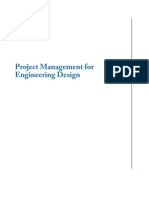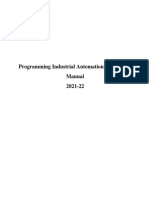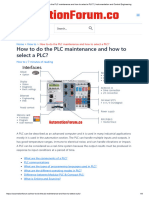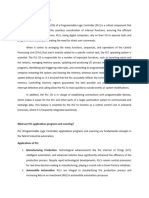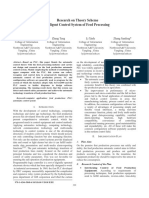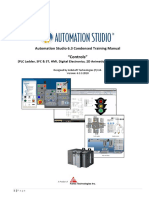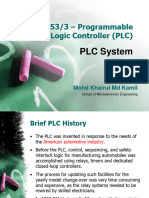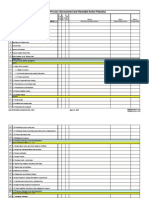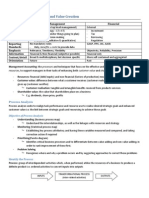Introduction To PLC
Introduction To PLC
Uploaded by
Pravin BeheraCopyright:
Available Formats
Introduction To PLC
Introduction To PLC
Uploaded by
Pravin BeheraOriginal Description:
Original Title
Copyright
Available Formats
Share this document
Did you find this document useful?
Is this content inappropriate?
Copyright:
Available Formats
Introduction To PLC
Introduction To PLC
Uploaded by
Pravin BeheraCopyright:
Available Formats
Introduction to PLC:
Programmable logic control or PLC is the most commonly used industrial automation
technique in the world. It is universally applied for factory automation, process control and
manufacturing systems. Programmable logic control originated from the creation of
computerized versions of relay control systems used to control manufacturing and chemical
process systems. The programming is done using a special technique called ladder logic,
which allows sequences of logical actions to be set up, inter-linked and timed. A standard
task in logic control is batch control and sequencing in a process system. PLC allows as
controlling an automated process. Automation
1. Gain complete control of manufacturing process.
2. Achieve helps a manufacturing facility to- consistency in manufacturing
3. Improve quality & accuracy
4. Work in difficult or hazardous environments
5. Increase productivity
6. Shorten the time to market
7. Lower the cost of quality, scrap & rework
8. Offer greater product variety
9. Quality charge over from one product to another
10. Control inventory
A PLC is a user friendly, microprocessor specialized computer that carries out control
functions of many types and levels of complexity. Its purpose is to monitor crucial process
parameters and adjust process operations accordingly. It can be programmed, controlled and
operated by a person unskilled in operating computers. Essentially, a PLC's operator draws
the lines and devices of ladder diagrams with a keyboard onto a display screen. The
resulting drawing is converted into computer machine language and run as a user program.
Architecture of PLC:
Basic Structure of PLC
PLC scan cycle :
A PLC works by continually scanning a program. We can think of this scan cycle as
consisting of 3 important steps. There are typically more than 3 but we can focus on the
important parts and not worry about the others. Typically the others are checking the system
and updating the current internal counter and timer values.
PLC operation
Advantage of PLC:
Programmable Logic Controllers have been gaining popularity on the factory floor and will
probably remain predominant for some time to come. Most of this is because of the
advantages they offer. With the growth in technology PLCs are now capable of advanced
data manipulations, communications and process controls. Benefits of using PLC in
industries are
1. The PLC is a hardened industrial computer designed to withstand the harsh
factory environment.
2. PLSs is reusable they contain a changeable program that eliminators extensive
and component changes.
3. PLCs offer easy troubleshooting
4. PLCs feature easy installation and small size.
Some of the used Instructions:
Examine if Closed (XIC)
Use the XIC instruction in your ladder to determine if a bit is on. When the instruction is
executed, if the bit addressed is on (1), then the instruction is evaluated as true. When the
instruction is executed, if the bit addressed off (0),
then the instruction is evaluated as false.
Examine if Open (XIO)
Use an XIO instruction in your ladder program to determine if a bit is off. When the
instruction is executed, if the bit addressed is off (0), then the instruction is
evaluated as true. When the instruction is evaluated as false.
Timer On-Delay (TON)
Use the TON instruction to turn an output on or off after the timer has been on for a
preset time interval. The TON instruction begins to count time base intervals when
rung conditions become true. As long as rung conditions remain true, the timer
adjusts its accumulated value (ACC) each evaluation until it reaches the preset
value (PRE). The accumulated value is reset when rung conditions go false,
regardless of whether the timer has timed out.
You might also like
- Project Management For Engineering DesignDocument120 pagesProject Management For Engineering DesignTushar Sharma100% (3)
- PLC Full ReportDocument10 pagesPLC Full ReportJian Jie0% (1)
- Electrical Machines I by U A Bakshi V U BakshiDocument355 pagesElectrical Machines I by U A Bakshi V U Bakshinetgalaxy201071% (7)
- VDA 6.3 Based Supplier AssessmentDocument11 pagesVDA 6.3 Based Supplier AssessmentGrecu Dragos100% (1)
- Group 3 CostingDocument68 pagesGroup 3 CostingPY SorianoNo ratings yet
- Teaching PLC Chap1Document38 pagesTeaching PLC Chap1mhafizanNo ratings yet
- PLC Teaching BookDocument167 pagesPLC Teaching BookMitchell Daniels100% (5)
- Programmable Logic ControllerDocument4 pagesProgrammable Logic ControllerBlack PigeonNo ratings yet
- Programming Industrial Automation Laboratory Manual 2021-22Document60 pagesProgramming Industrial Automation Laboratory Manual 2021-22Insane PersonNo ratings yet
- Athar File111Document35 pagesAthar File111atharNo ratings yet
- PLC Solution BookDocument49 pagesPLC Solution BookJagadeesh Rajamanickam71% (14)
- How To Do The PLC Maintenance and How To Select A PLC - Instrumentation and Control EngineeringDocument8 pagesHow To Do The PLC Maintenance and How To Select A PLC - Instrumentation and Control EngineeringShivaji ThubeNo ratings yet
- LabManual (3381)Document179 pagesLabManual (3381)schaefer1015719100% (1)
- Programmable Logic ControllerDocument10 pagesProgrammable Logic Controllerfarah nazNo ratings yet
- Share ProcesssssssDocument42 pagesShare ProcesssssssMuskan JainNo ratings yet
- Introduction To PLCDocument14 pagesIntroduction To PLCMeowwwewNo ratings yet
- Chapter 1 - PLC IntroductionDocument30 pagesChapter 1 - PLC IntroductionMohamed ShehadiNo ratings yet
- PLC Programming & Implementation: An Introduction to PLC Programming Methods and ApplicationsFrom EverandPLC Programming & Implementation: An Introduction to PLC Programming Methods and ApplicationsNo ratings yet
- Programming Logic Controller (PLC)Document3 pagesProgramming Logic Controller (PLC)tantiana parangNo ratings yet
- Industrial Automation: AbstractDocument13 pagesIndustrial Automation: AbstractRamanan MageswaranNo ratings yet
- Programmable Logic Controller: What Is A PLC?Document22 pagesProgrammable Logic Controller: What Is A PLC?Shuaib AbdulmuhizNo ratings yet
- Lab 8Document8 pagesLab 8kashif anwarNo ratings yet
- Lab 01 - Introduction To PLC Hardware and SoftwareDocument18 pagesLab 01 - Introduction To PLC Hardware and SoftwareSyed Abdullah Hasan Chishti100% (1)
- Load Management SystemDocument40 pagesLoad Management Systematul mishraNo ratings yet
- PLC in Industrial Control: Ing. Marie Martinásková, Ph.D. Ing. Jakub JURADocument65 pagesPLC in Industrial Control: Ing. Marie Martinásková, Ph.D. Ing. Jakub JURAAllan CorreaNo ratings yet
- PLC and Scada Systems: Programmable Logic Controller Supervisory Control and Data AcquisitionDocument35 pagesPLC and Scada Systems: Programmable Logic Controller Supervisory Control and Data AcquisitionjustinkikoNo ratings yet
- Chapter 1 (PLC)Document9 pagesChapter 1 (PLC)Kibria PrangonNo ratings yet
- Programmable Logic Controller (PLC) Is A Digital Computer Used For The Automation of VariousDocument23 pagesProgrammable Logic Controller (PLC) Is A Digital Computer Used For The Automation of VariousSunil ChaudhariNo ratings yet
- EENG500-Chap1-PLC OverviewDocument34 pagesEENG500-Chap1-PLC OverviewHasan JomaaNo ratings yet
- PLC 1703025724Document14 pagesPLC 1703025724Yeyen RoyhanNo ratings yet
- PLC QuestionsDocument17 pagesPLC QuestionsbahyNo ratings yet
- M.Module 4Document23 pagesM.Module 4Jishnu PrakashNo ratings yet
- Everything About Programmable Logic Cont PDFDocument4 pagesEverything About Programmable Logic Cont PDFFahim AkterNo ratings yet
- PLCDocument56 pagesPLCFelix Lee Kah NgieNo ratings yet
- PLC BasicsDocument20 pagesPLC BasicsTalha_Gujjar_4662No ratings yet
- PLC Workshop 1-2 DayDocument120 pagesPLC Workshop 1-2 DayHamza Khan Khattak100% (1)
- 5 ToDocument3 pages5 ToYeferson Eusebio Lloclla EscobarNo ratings yet
- Aiet 383 Plcs 03Document9 pagesAiet 383 Plcs 03talha 8byt TalhaNo ratings yet
- A PLC-BasicDocument56 pagesA PLC-BasicMarc RodaviaNo ratings yet
- Tahmid Rongon: Programmable Logic ControllerDocument31 pagesTahmid Rongon: Programmable Logic ControllerJanmenjay DesaiNo ratings yet
- PLC Interview QuestionsDocument16 pagesPLC Interview QuestionsKenneth NdzimandzeNo ratings yet
- Logic Control and PLCsDocument6 pagesLogic Control and PLCsKRISHNA KANT GUPTANo ratings yet
- Introduction To P.L.C: Software TrainingDocument44 pagesIntroduction To P.L.C: Software TrainingSantpreet Singh KalraNo ratings yet
- As 6.3 Condensed Training Manual March 2018 - ControlsDocument30 pagesAs 6.3 Condensed Training Manual March 2018 - ControlsSamir NandardhaneNo ratings yet
- 563 2046 1 PB PDFDocument11 pages563 2046 1 PB PDFWaleed AliNo ratings yet
- 04 - Step by Sptep Procedure For The Usage of Crouzet Millenium 3 PLC With ExercisesDocument225 pages04 - Step by Sptep Procedure For The Usage of Crouzet Millenium 3 PLC With Exercises447 KusumanjaliNo ratings yet
- LabExercise 9 - Dynamic Systems SimulationDocument16 pagesLabExercise 9 - Dynamic Systems SimulationQueenie Rose PercilNo ratings yet
- Lect 11 21 PLCDocument58 pagesLect 11 21 PLCraja_liaqatNo ratings yet
- Workshop 5th Semester Report PDFDocument70 pagesWorkshop 5th Semester Report PDFJasonNo ratings yet
- 05-Introduction To PLCDocument63 pages05-Introduction To PLCMohamed Gawad ARayaNo ratings yet
- PLC 1Document54 pagesPLC 1Abdo HeshamNo ratings yet
- Basics of PLCSDocument45 pagesBasics of PLCSarsalankhurshid100% (1)
- PLC EditedDocument45 pagesPLC EditedSantpreet Singh KalraNo ratings yet
- IA FinalDocument37 pagesIA FinalRoshan SuvarnaNo ratings yet
- PLC ScriptDocument3 pagesPLC Scriptsreekanthtg007No ratings yet
- Programmable Logic Controllers (PLC) : (Reading For "Elements of Industrial Automation" at ELDE)Document0 pagesProgrammable Logic Controllers (PLC) : (Reading For "Elements of Industrial Automation" at ELDE)rajserajNo ratings yet
- PLC System PDFDocument22 pagesPLC System PDFSummer TriangleNo ratings yet
- PLC SystemDocument22 pagesPLC Systemsyedyaship786.yyNo ratings yet
- 2 MarksDocument5 pages2 MarksPriya DharshiniNo ratings yet
- Solved Syllabus For Mid Exam Manufacturing AutomationDocument4 pagesSolved Syllabus For Mid Exam Manufacturing AutomationFaheem AbbasNo ratings yet
- What Is A Programmable Logic Controller (PLC) ?: Products by Size by Series Customized EnclosuresDocument11 pagesWhat Is A Programmable Logic Controller (PLC) ?: Products by Size by Series Customized EnclosuresTrisha SambranoNo ratings yet
- PLC Programming Using RSLogix 500 & Industrial Applications: Learn ladder logic step by step with real-world applicationsFrom EverandPLC Programming Using RSLogix 500 & Industrial Applications: Learn ladder logic step by step with real-world applicationsRating: 5 out of 5 stars5/5 (1)
- February 2020 Number 2 Ietaa9 (ISSN 0018-9286) : Regular PapersDocument2 pagesFebruary 2020 Number 2 Ietaa9 (ISSN 0018-9286) : Regular PapersPravin BeheraNo ratings yet
- STEFANI Solution ManualDocument309 pagesSTEFANI Solution ManualPravin BeheraNo ratings yet
- Linear Algebra Problem Book - HalmosDocument176 pagesLinear Algebra Problem Book - HalmosThyago MendesNo ratings yet
- Localization Control of Lego Mobile RobotDocument6 pagesLocalization Control of Lego Mobile RobotPravin BeheraNo ratings yet
- Using LEGO NXT Mobile Robots With LabVIEW For Undergraduate Courses On MechatronicsDocument7 pagesUsing LEGO NXT Mobile Robots With LabVIEW For Undergraduate Courses On MechatronicsPravin BeheraNo ratings yet
- APQP-PPAP WorkbookDocument35 pagesAPQP-PPAP WorkbookChandru JattiNo ratings yet
- Best Metal Casting DesignDocument71 pagesBest Metal Casting DesignVijay Pawar100% (2)
- Solid Waste Management in Malaysia-CompleteDocument2 pagesSolid Waste Management in Malaysia-CompleteungkumariamNo ratings yet
- I. Overheads Recap From Session 3: Exercise: D&W Handout Template For Session 4Document9 pagesI. Overheads Recap From Session 3: Exercise: D&W Handout Template For Session 4Jules VautrinNo ratings yet
- Team Leader Based OrganizationDocument17 pagesTeam Leader Based OrganizationUmesh Saranga Abeydheera100% (1)
- Engineering Management in Offshore Projects Uten Film 4Document40 pagesEngineering Management in Offshore Projects Uten Film 4limresNo ratings yet
- Answer P5-2Document2 pagesAnswer P5-2Prilly ManembuNo ratings yet
- An Assessement of Material Management On The Profitability of Manufacturing Companies in LiberiaDocument18 pagesAn Assessement of Material Management On The Profitability of Manufacturing Companies in LiberiaBenjamin P. JonesNo ratings yet
- Tape ReelDocument6 pagesTape ReelRismawanZulhiNo ratings yet
- Test Bank For Managerial Accounting, 17e Ray Garrison, Eric Noreen, Peter BrewerDocument53 pagesTest Bank For Managerial Accounting, 17e Ray Garrison, Eric Noreen, Peter Brewershehzadfarukh68No ratings yet
- APQP Process AssessmentDocument3 pagesAPQP Process AssessmentSergio ArellanoNo ratings yet
- ACCT2522 Final NotesDocument38 pagesACCT2522 Final Noteskittyangel_01100% (1)
- 03 Global Quality and International Quality StandardsDocument50 pages03 Global Quality and International Quality StandardsM Sayid DwiNo ratings yet
- Supply Chain Management (Assignment 2)Document3 pagesSupply Chain Management (Assignment 2)Muhammad Waqas HanifNo ratings yet
- Applications of Virtual Manufacturing in Materials ProcessingDocument8 pagesApplications of Virtual Manufacturing in Materials ProcessingEvelyn Iveren Kakwagh-IpilakyaaNo ratings yet
- Fundamental Factors Affecting QualityDocument10 pagesFundamental Factors Affecting Qualityvicky980212No ratings yet
- Clotan Steel - Purlin Span LengthsDocument3 pagesClotan Steel - Purlin Span LengthsColin SillmanNo ratings yet
- AccountingDocument69 pagesAccountingakshit_vijNo ratings yet
- Toyota Production System PDFDocument28 pagesToyota Production System PDFJose Francisco VargasNo ratings yet
- Implementation of Six Sigma in MotorolaDocument18 pagesImplementation of Six Sigma in MotorolaAnonymous GGtvR65MR75% (4)
- 1 Production EngineeringDocument23 pages1 Production EngineeringSVK 4UNo ratings yet
- Software Testing Revision NotesDocument12 pagesSoftware Testing Revision NotesVenkatesh VuruthalluNo ratings yet
- CNC Ú ÊÖ À Ì °Ê ÀýDocument132 pagesCNC Ú ÊÖ À Ì °Ê ÀýxevniNo ratings yet
- 13 Design For Manufacturing and Supply ChainDocument15 pages13 Design For Manufacturing and Supply Chainsalladım TuttuNo ratings yet
- Lean - Theory To PracticeDocument4 pagesLean - Theory To PracticePranab SalianNo ratings yet
- MSP ProceduresDocument18 pagesMSP ProcedurestarunNo ratings yet
- Lean Manufacturing Lec 5.2Document41 pagesLean Manufacturing Lec 5.2Muhammad KhalilNo ratings yet
